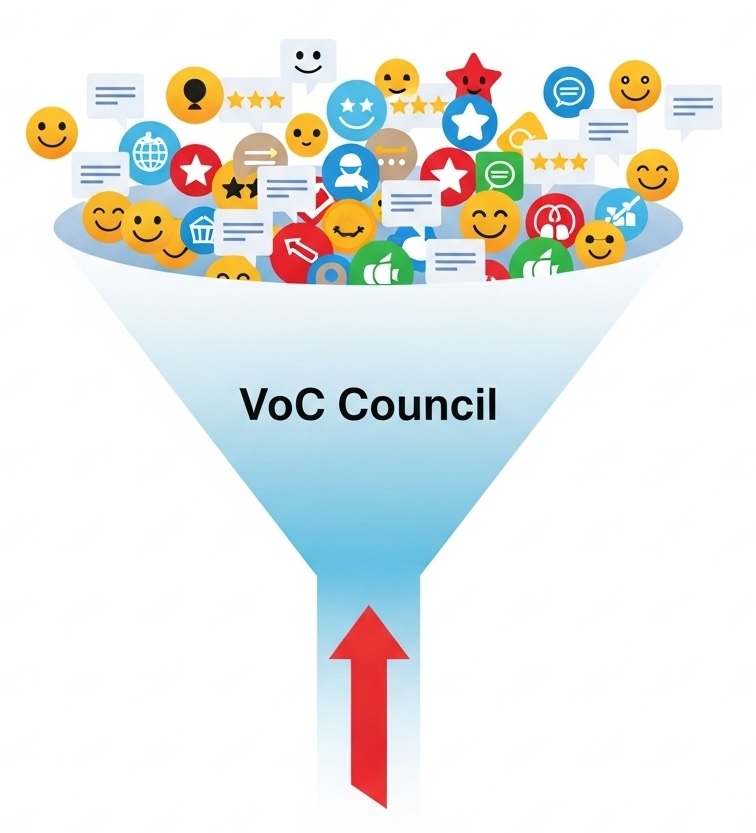In this unit, you’ll discover how to transform customer feedback into real, company-wide improvements by building effective cross-functional governance. As organizations grow, it’s easy for customer pain points to get lost between teams. By mastering the skills in this unit, you’ll ensure that every function—Product, Engineering, Sales, and beyond—takes shared ownership of customer outcomes and acts on them.
Customer-centricity isn’t just a Customer Success goal; it’s a business imperative. When teams operate in silos, recurring issues—like "40% of support tickets are caused by the same product defect"—can persist for months, frustrating both customers and employees. Cross-functional governance brings together the right voices to prioritize, act, and follow through on what matters most to your customers and your bottom line.
A well-structured governance model means you can align everyone around shared objectives, such as "Reduce defect-related churn by 20%", and ensure that progress is tracked and celebrated. This approach not only improves customer retention but also drives revenue growth and operational efficiency.
A Voice-of-Customer (VoC) council is your mechanism for turning scattered feedback into focused action. The most effective councils are lean, cross-functional, and outcome-driven. Instead of adding to “meeting overload,” design sessions that are short, data-driven, and have a clear decision process. For example, you might propose "bi-weekly, 45-minute meetings with pre-read data and a rotating chair" to keep things efficient and inclusive.

Securing buy-in from busy teams requires empathy and clarity. If Engineering is worried about more meetings, show how the council will actually reduce unplanned hot-fix interruptions by prioritizing systemic fixes. Make commitments visible by naming a delegate from each function and tracking action items to closure. The goal is to move from "Support keeps flagging the same issue" to "Engineering, Product, and Support jointly own the fix and timeline."
Once your VoC council is up and running, the next step is to translate customer insights into company-level priorities. This often means facilitating executive sessions where customer-focused OKRs compete with commercial targets. Your role is to help leaders weigh trade-offs using data and business impact. For instance, you might say, "Fixing the top three defects could save $1.2M in at-risk renewals—here’s how that compares to the projected revenue from new features."
When priorities conflict, your job is to negotiate a stack-ranked list that both Product and Sales can support, and to document clear owners and deadlines for each action item. If deliverables slip, escalate early and factually: "The root-cause analysis for our #1 defect is overdue, putting $400K in renewals at risk. I propose assigning a recovery owner and setting a new deadline before next Monday’s ops review." This keeps the focus on outcomes, not blame, and preserves trust across teams.
- Jessica: Ryan, Support is seeing a spike in tickets about the same integration bug. If we don’t address it, we risk losing two major accounts this quarter.
- Ryan: I get the urgency, but my team is already stretched thin with roadmap work. Another meeting isn’t going to help unless it leads to real action.
- Jessica: That’s exactly why I’m proposing a bi-weekly, 45-minute VoC council. We’ll use pre-read data to focus only on the top issues, and each function will own specific action items. For this bug, Engineering, Product, and Support would jointly commit to a fix and timeline.
- Ryan: If it actually cuts down on last-minute hot-fixes and keeps meetings short, I’m in. Let’s make sure we track progress and don’t let things slip.
- Jessica: Agreed. I’ll circulate a draft charter and name delegates from each team so we’re all accountable.
In this exchange, Jessica demonstrates how to secure buy-in for a VoC council by addressing Ryan’s concerns about meeting overload and focusing on measurable outcomes. Notice how she uses specific examples ("spike in tickets about the same integration bug", "bi-weekly, 45-minute VoC council") and ties the council’s purpose directly to business impact and accountability.
